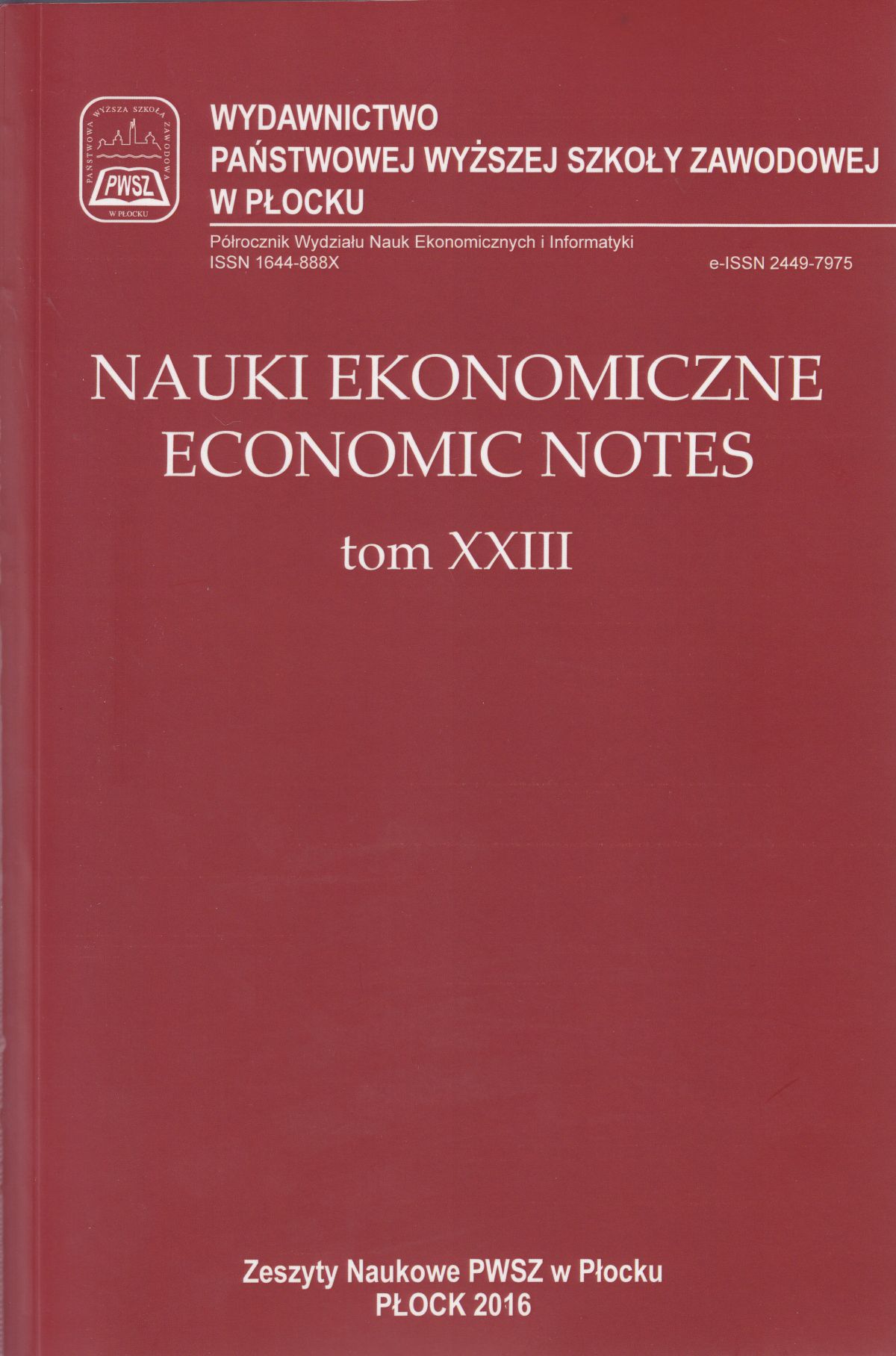DLACZEGO HISZPANIA NIE RADZI SOBIE W STREFIE EURO? ANALIZA POLITYKI PIENIĘŻNEJ BANKU HISZPANII W LATACH 1990-1998
Abstract
Streszczenie:
Okres 1990-1998 był etapem przejściowym w polityce gospodarczej Hiszpanii.
Głównym celem, do którego dążono w tym okresie, było spełnienie
warunków konwergencji, które umożliwiłby Hiszpanii wejście do Unii Gospodarczo-
Walutowej. Osiągnięcie tego założenia wywarło znaczny wpływ na
politykę pieniężną Banku Hiszpanii w latach 90. Najważniejszymi czynnikami
wywołującymi wzrost cen w Hiszpanii w pierwszej połowie lat 90. były:
presja płacowa oraz kilkakrotne dewaluacje. Bank centralny wobec luźnej
polityki fiskalnej musiał prowadzić restrykcyjną politykę monetarną, aby nie
dopuścić do dalszego zwiększania inflacji.
Słowa kluczowe: gospodarka Hiszpanii, Bank Hiszpanii, polityka pieniężna,
stopy procentowe, inflacja.
References
Bibliografia:
• Alberola Enrique, Ayuso Juan and Lopez-Salido David. 1997. When May Peseta
Depreciations Fuel Inflation? Bank of Spain.
• Andres Javier, Mestre Ricardo and Valles Javier. 1997. A structural model for the
analysis of the monetary transmission mechanism. Forthcoming in Monetary Policy
and Inflation in Spain. McMillan.
• Baka Władysław.2001. Bankowość centralna. Funkcje, metody, organizacja.
Warszawa.
• Banco de Espana. 1990. 1991. 1992. 1993. 1994. 1995. 1996. 1997. 1998. 1999.
2001. 2002. Annual Report.
• Banco de Espana. 1998b. Convergence Report presented by the Governor of the
Banco de Espana.
• Bernanke Ben Shalom and Gertler Mark. 1995. „Inside the black box: the credit
channel of monetary policy transmission”. The Journal of Economic Perspectives,
(4), pp. 27-48.
• Buiter Willem and Miller Marcus. 1981. Monetary Policy and International Competitiveness:
the problems of adjustment, Oxford Economic Papers, 143-175.
• Canzoneri Matthew, Valles Javier and Vinals Jose. 1996. “Do exchange rates move
to address international macroeconomic imbalances?”. CEPR , Discussionpaper,
nQ 1498.
• Chałupa Tadeusz. 2011. Koniunktura gospodarcza w wybranych krajach w okresie
kryzysu finansowego. Warszawa: Ministerstwo Gospodarki, s. 24-26.
• Clarida Richard and Gali Jordi. 1994. Sources of real exchange rate fluctuations:
How important are nominal shocks? Carnegie-Rochester Conference series on Public Policy, 41.
• Ehrmann Michael, Gambacorta Leonardo, Martínez Pagés Jorge, Sevestre Patrick
and Worms Andreas. 2001. “The role of banks in monetary policy transmission in
the euro area”. Banco de España Working Paper no.0118.
• Eichenbaum Martin and Evans Charles. 1995. “Some empirical evidence on the
effects of shocks to monetary policy on exchange rates”. Quarterly Journal of
Economics, 105, 975-1009.
• Goodfriend Marvin. 1995. The impact of monetary policy on bank balance sheets:
A comment, Carnegie-Rochester Conference Series on Public Policy, 42,
pp. 197-202.
• Gourinchas Pierre-Olivier and Tornell Aaron. 1996. “Exchange rate dynamics and
learning, Harvard Institute of Economic Research”. Discussion Paper 1771.
• Grilli Vittorino and Roubini Nouriel. 1992. “Liquidity and exchange rates”. Journal
of International Economics, 32, 339-352.
• “Hiszpańskie banki dostaną 37 mld euro”, Dostępny w Internecie.
• IMF. 1997. Spain Recent Economic Developments and Selected Issues. IMF Staff
Country Report No. 97/39, International Monetary Fund, May.
• Jareiio Jase Maria, Sebastian Miguel and Valles Javier. 1997. Identifying monetary
policy in Spain. Bank of Spain.
• Kashyap Anil and Stein Jeremy. 1995. The impact of monetary policy on bank
balance sheets. Carnegie-Rochester Conference Series on Public Policy, 42,
pp. 151-195.
• Kashyap Anil and Stein Jeremy. 2000. “What do a million observations on banks
say about the transmission of monetary policy?”. American Economic Review, 90,
pp. 407-428.
• Kim Soyoung. 1997. Identifying monetary policy interactions: Who stabilizes the
intra-European exchange rate. Bank of Spain.
• Kishan Ruby P and Opiela Timothy P. 2000. “Bank size, bank capital and the bank
lending channel”. Journal of Money, Credit and Banking, 32(1), pp. 121-141.
• Kollmann Robert. 1997. The exchange rate in a dynamic-optimizing current account
model with nominal rigidities: a quantitative investigation. International
Monetary Fund, WP/97/7.
• “Kryzys w Hiszpanii. Jest decyzja eurogrupy”, Dostępny w Internecie.
• „Kryzys w Hiszpanii. Rząd przygotował zmiany gospodarcze”, Dostępny
w Internecie.
• Malo de Molina Jose Luis, Gutierres Fred (red.). 1998. Monetary Policy and Inflation
in Spain. Banco de Espana.
• Manzano Maria Cruz and Galmés Sofia. 1996. “Credit institutions’ price policies
and type of customer: impact on the monetary transmission mechanism”. Banco
de España Working paper no.9605.
• Mojon Benoit. 1999. Credit channel(s) in the euro area: what is the evidence of
distributional effects?. Banco de Espana.
• Morgan Donald. 1998. “The credit effects of monetary policy: evidence using loan
commitments”. Journal of Money, Credit and Banking, 30, pp. 102-118.
• Pill Herman. 1996. “Bank behaviour and monetary policy in a small open economy:
the case of Spain”. Banco de España.
• “Pomoc dla Hiszpanii. Zapadła ważna decyzja”, Dostępny w Internecie.
• Sastre Teresa. 1998. The role of the banking system in the monetary transmission
mechanism. In Monetary policy and inflation in Spain, ed. Jose Luis Malo de Molina
et al. Banco de España.
• [www 1] http://epp.eurostat.ec.europa.eu.
• [www 2] http://www.oecd-ilibrary.org.
• [www 3] http://www.tradingeconomics.com.
• [www 4] https://www.google.pl/publicdata.
